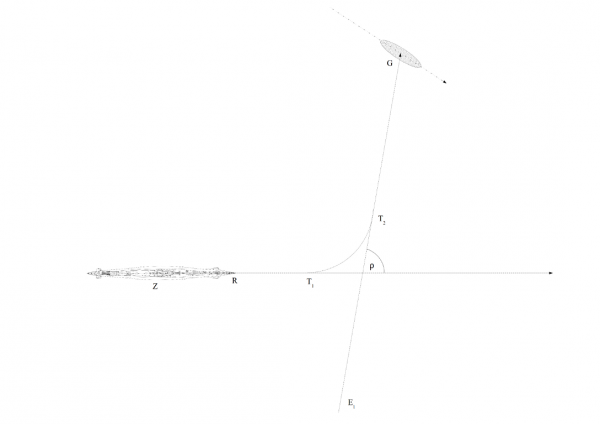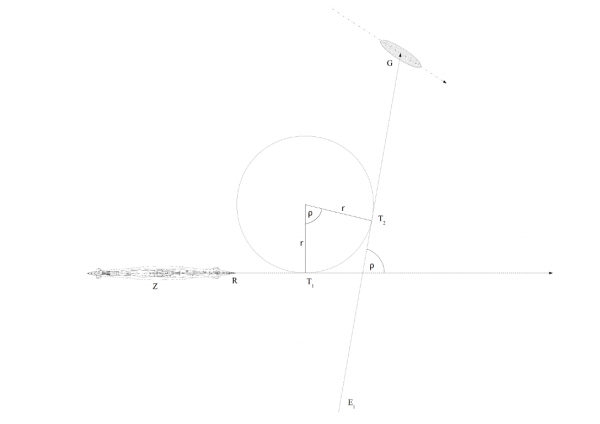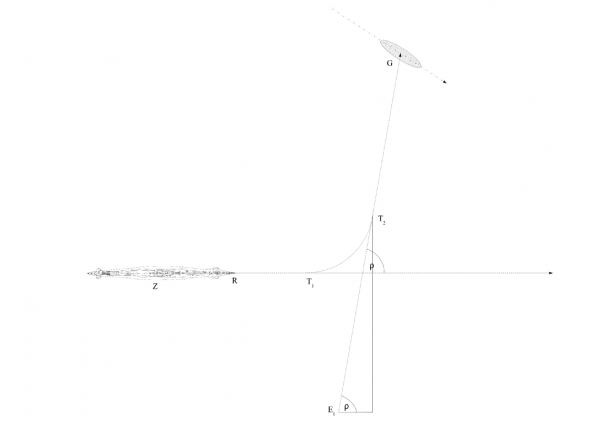Derivation of the formulas used in the mathematical model of the calculator
The description of the calculator does not contain - due to readability - detailed derivation of all formulas. These derivations are presented below.
Derivation of the formula for calculating the deflection angle
Let's transform the following initial formula:
\[\begin{aligned} sin β = \frac{v_{g}}{v_{t}} * sin γ \end{aligned} \]
in such way, that deflection angle β depends on the torpedo impact angle α and quotient \(\frac{v_{g}}{v_{t}} \).
Because one of the input values of the component for solving the torpedo triangle is quotient \(\frac{v_{g}}{v_{t}} \), let's make following substitution::
\[\begin{aligned} u = \frac{v_{g}}{v_{t}} \end{aligned} \]
which results in:
\[\begin{aligned} sin β = u * sin γ \end{aligned} \]
Because in any triangle, the sum of all three angles is always equal to 180°, the following formula can be written:
\[\begin{aligned} γ = 180° - (α + β) \end{aligned} \]
Having in mind the periodic feature of the sines function – that is the feature that:
\[\begin{aligned} sin α = sin (180° - α) \end{aligned} \]
we get:
\[\begin{aligned} sin γ = sin (α + β) \end{aligned} \]
So finally we get:
\[\begin{aligned} sin β = u * sin (α + β) \end{aligned} \]
This formula can be transformed in the following way:
\[\begin{aligned} sin β = u * (sin α * cos β + cos α * sin β) \end{aligned} \]
\[\begin{aligned} 1 = u * \frac{(sin α * cos β + cos α * sin β)}{sin β} \end{aligned} \]
\[\begin{aligned} 1 = u * (sin α * ctg β + cos α) \end{aligned} \]
\[\begin{aligned} 1 - u * cos α = u * sin α * ctg β \end{aligned} \]
\[\begin{aligned} ctg β = \frac{1 - u * cos α}{u * sin α} = \frac{1}{u * sin α} - ctg α \end{aligned} \]
So the deflection angle β can be calculated based on the quotient of the target and torpedo speed and knowing the torpedo impact angle using the following formula:
\[\begin{aligned} β = arcctg (\frac{1}{u * sin α} - ctg α \end{aligned}) \]
Derivation of the formula for Cartesian coordinates of the equivalent point of fire
The torpedo track consists of three parts: the initial, straight run RT1, the arc T1T2, when the torpedo turns to its final course, and the segment T2G, which is the final torpedo run until hitting the target.
Drawing 1
The equivalent point of fire E1 is located at the line, which overlaps the final torpedo run. It is located in the distance |E1T2| equal to the sum of the length of the arc T1T2 and the segment RT1. The length of the segment |RT1| is constant and for German World War II torpedoes was equal to 9.5 m. The length of the arc |T1T2| depended on the gyro angle ρ.
The Cartesian coordinates x0 and y0 of the equivalent point of fire E1 relative to the location of the aiming device Z (which was distanced from the torpedo tubes by 27 meters on type VIIC U-Boats) can be determined in the following way:
The coordinates xr and yr of the torpedo tubes R relative to the location of the aiming device Z are:
\[\begin{aligned} (x_{r}; y_{r}) = (27; 0) \end{aligned}\]
The coordinates of the point T1 relative to the location of the aiming device Z:
\[\begin{aligned} (x_{T1}; y_{T1}) = (x_{r}; y_{r}) + (9,5; 0) = (27; 0) + (9,5; 0) \end{aligned}\]
The position of the point T2 (relative to the point T1) can be determined from the following formula (after noticing, that the angle constructed at the arc T1T2 is equal to the gyro angle ρ):
\[\begin{aligned} (x_{T2}; y_{T2}) = (r * sin ρ; r – r * cos ρ) \end{aligned}\]
where r – turn radius, which was equal to 95 m for German World War II torpedoes.
Whereas, relative to the aiming device location, the coordinates are:
\[\begin{aligned} (x_{T2}; y_{T2}) = (r * sin ρ; r – r * cos ρ) + (27; 0) + (9,5; 0) \end{aligned}\]
Drawing 2
The length of the arc T1T2 is
\[\begin{aligned} |T_{1}T_{2}| = ρ * r \end{aligned}\]
where angle ρ is expressed in radians.
As mentioned before, the distance between the point E1 and point T2 is equal to the sum:
\[\begin{aligned} |E_{1}T_{2}| = |RT_{1}| + |T_{1}T_{2}| \end{aligned}\]
that is
\[\begin{aligned} |E_{1}T_{2}| = 9,5 + ρ * r \end{aligned}\]
Coordinates of the point E1 relative to the point T2 are:
\[\begin{aligned} (x_{E1}; y_{E1}) = (x_{T2}; y_{T2}) – (|E_{1}T_{2}| * cos ρ; |E_{1}T_{2}| * sin ρ) \end{aligned}\]
Drawing 3
Coordinates of the point E1 relative to the aiming device Z location:
\[\begin{aligned} (x_{E1}; y_{E1}) = (r * sin ρ; r – r * cos ρ) + (27; 0) + (9,5; 0) – (|E_{1}T_{2}| * cos ρ; |E_{1}T_{2}| * sin ρ) \end{aligned}\]
After inserting the formula determining the length of the segment |E1T2| we get:
\[\begin{aligned} (x_{E1}; y_{E1}) = (r * sin ρ; r – r * cos ρ) + (27; 0) + (9,5; 0) – ((9,5 + ρ * r) * cos ρ; (9,5 + ρ * r )* sin ρ) \end{aligned}\]
So the coordinates of the point E1 are:
\[\begin{cases} x_{E1} = r * sin ρ + 27 + 9,5 – (9,5 + ρ * r) * cos ρ \\ y_{E1} = r – r * cos ρ – (9,5 + ρ * r) * sin ρ \end{cases}\]
that is
\[\begin{cases} x_{E1} = 27 + 9,5 + 95 * sin ρ – (9,5 + ρ * 95) * cos ρ \\ y_{E1} = 95 * (1 – cos ρ) – (9,5 + ρ * 95) * sin ρ \end{cases}\]
Derivation of the formula for calculating the torpedo salvo spread angle
The transformation of the following formula
\[\begin{aligned} \frac{E - λ * cos γ}{v_{t} * cos β + v_{g} * cos γ} = \frac{λ * sin γ}{v_{t} * sin β – v_{g} * sin γ} \end{aligned}\]
we are beginning from dividing denominators at both sides of equation by vt, which results in
\[\begin{aligned} \frac{E - λ * cos γ}{cos β + \frac{v_{g}}{v_{t}} * cos γ} = \frac{λ * sin γ}{sin β – \frac{v_{g}}{v_{t}} * sin γ} \end{aligned}\]
Then the following substitution is done:
\[\begin{aligned} u = \frac{v_{g}}{v_{t}} \end{aligned}\]
getting:
\[\begin{aligned} \frac{E - λ * cos γ}{cos β + u * cos γ} = \frac{λ * sin γ}{sin β – u * sin γ} \end{aligned}\]
After dividing the numerators at both sides of equation by E we get:
\[\begin{aligned} \frac{1 - \frac{λ}{E} * cos γ}{cos β + u * cos γ} = \frac{\frac{λ}{E} * sin γ}{sin β – u * sin γ} \end{aligned}\]
Then we make following substitution:
\[\begin{aligned} μ = \frac{λ}{E} \end{aligned}\]
getting:
\[\begin{aligned} \frac{1 - μ * cos γ}{cos β + u * cos γ} = \frac{μ * sin γ}{sin β – u * sin γ} \end{aligned}\]
Then the following transformations are performed:
\[\begin{aligned} (1 - μ * cos γ)*(sin β – u * sin γ) = (μ * sin γ)*(cos β + u * cos γ) \end{aligned}\]
\[\begin{aligned} sin β - u * sin γ - μ * cos γ * sin β + μ * u * sin γ * cos γ = μ * sin γ * cos β + μ * u * sin γ * cos γ \end{aligned}\]
\[\begin{aligned} sin β - u * sin γ = μ * sin γ * cos β + μ * cos γ * sin β \end{aligned}\]
\[\begin{aligned} sin β - u * sin γ = μ * (sin γ * cos β + cos γ * sin β) \end{aligned}\]
finally getting:
\[\begin{aligned} sin β - u * sin γ = μ * sin (γ + β) \end{aligned}\]
This is implicit equation, which can be used for calculating the deflection angle β for the target as seen with the angle on the bow γ, so the torpedo hits the point distanced by the value λ from the middle of the target.
For convenience, instead considering the stern and bow location as distances λ from the middle of the target, the following substitution can be done:
\[\begin{aligned} μ_{0} = \frac{l}{2*E} \end{aligned}\]
where l – length of the target.
To make three-torpedo salvo hitting the bow, middle and stern of the target of length l, each torpedo has to be launched with the deflection angle β0, β and β1 respectively, where each of these values meets one of the following equations:
\[\begin{cases}sin β_{0} – u * sin γ = μ_{0} * sin (β_{0} + γ) \\ sin β – u * sin γ = 0 \\ sin β_{1} – u * sin γ = - μ_{0} * sin (β_{1} + γ)\end{cases}\]
Because, in practice, in most cases the target (with the length up to 150 meters – i.e. Liberty type cargo ships: ~135 meters, T2 type tankers: ~152 meters) were attacked from the minimum distance 500 meters, the value μ0 is rather small (μ0 < 0,15). That means, that angle between the courses of torpedoes aimed into target bow and stern (that is angle β1 - β0) is equal maximum ~20º. Knowing the fact, that for the angles α in range 0 – 20º, the sin α ~ α and cos α ~ 1, the following equations can be written:
\[\begin{align} sin β_{0} = sin (β_{0} - β + β) = sin (β_{0} - β) * cos β + cos (β_{0} - β) * sin β \end{align}\]
and
\[\begin{align} sin β_{1} = sin (β_{1} - β + β) = sin (β_{1} - β) * cos β + cos (β_{1} - β) * sin β \end{align}\]
Using the feature of the sines and cosines functions for small angles mentioned above, the equations above can be written in the following way:
\[\begin{align} sin β_{0} = (β_{0} - β) * cos β + sin β \end{align}\]
and
\[\begin{align} sin β_{1} = (β_{1} - β) * cos β + sin β \end{align}\]
After inserting the formulas above into previous equations, we get:
\[\begin{cases} (β_{0} - β) * cos β + sin β - u * sin γ = μ_{0} * sin (β_{0} + γ) \\ sin β - u * sin γ = 0 \\ (β_{1} - β) * cos β + sin β - u * sin γ = -μ_{0} * sin (β_{1} + γ) \end{cases}\]
and after transforming:
\[\begin{cases} sin β - u * sin γ = μ_{0} * sin (β_{0} + γ) - (β_{0} - β) * cos β \\ sin β - u * sin γ = 0 \\ sin β - u * sin γ = -μ_{0} * sin (β_{1} + γ) - (β_{1} - β) * cos β \end{cases}\]
After inserting the second equation into the two others, we receive two formulas:
\[\begin{cases} 0 = μ_{0} * sin (β_{0} + γ) - (β_{0} - β) * cos β \\ 0 = -μ_{0} * sin (β_{1} + γ) - (β_{1} - β) * cos β \end{cases}\]
By comparing these two equations, we get:
\[\begin{aligned} μ_{0} * sin (β_{0} + γ) - (β_{0} - β) * cos β = -μ_{0} * sin (β_{1} + γ) - (β_{1} - β) * cos β \end{aligned}\]
which results in:
\[\begin{aligned} β_{0} - β_{1} = μ_{0} * \frac{sin (β_{0} + γ) + sin (β_{1} + γ)}{cos β} \end{aligned}\]
As mentioned before, the difference of the angles β1 - β0 in practice are maximum 20º. The sines function for angle values up to 20º can be approximated by linear function. Se we can write:
\[\begin{aligned} sin (β + γ) = \frac{sin (β_{0} + γ) + sin (β_{1} + γ)}{2} \end{aligned}\]
while
\[\begin{aligned} β \approx \frac{β_{0} + β_{1}}{2} \end{aligned}\]
So the torpedo salvo spread angle ψ (which is the difference β1 – β0) can be calculated by following formula:
\[\begin{aligned} ψ = 2 * μ_{0} * \frac{sin (β + γ)}{cos β} \end{aligned}\]
This equation can be transformed in the following steps, to avoid dependency from the deflection angle β:
\[\begin{aligned} ψ = 2 * μ_{0} * \frac{sin (β + γ)}{cos β} = \frac{l}{E} * \frac{sin (β + γ)}{cos β} = \frac{l}{E} * \frac{sin β * cos γ + cos β * sin γ}{cos β}\end{aligned}\]
\[\begin{aligned} ψ = \frac{l}{E} * \bigg(\frac{sin β * cos γ}{cos β} + \frac{cos β * sin γ}{cos β}\bigg) = \frac{l}{E} * (tg β * cos γ + sin γ)\end{aligned}\]
\[\begin{aligned} ψ = \frac{l}{E} * sin γ * \bigg(\frac{tg β * cos γ}{sin γ} + 1\bigg) = \frac{l}{E} * sin γ * \bigg(\frac{cos γ}{ctg β * sin γ} + 1\bigg) \end{aligned}\]
\[\begin{aligned} ψ = \frac{l}{E} * sin γ * \bigg(\frac{cos γ}{\frac{cos β}{sin β} * sin γ} + 1\bigg) = \frac{l}{E} * sin γ * \bigg(\frac{cos γ}{\sqrt{\frac{cos^2 β}{sin^2 β} * sin^2 γ}} + 1\bigg) \end{aligned}\]
\[\begin{aligned} ψ = \frac{l}{E} * sin γ * \bigg(\frac{cos γ}{\sqrt{\frac{1 - sin^2 β}{sin^2 β} * sin^2 γ}} + 1\bigg) = \frac{l}{E} * sin γ * \bigg(\frac{cos γ}{\sqrt{\frac{sin^2 γ - sin^2 β * sin^2 γ}{sin^2 β}}} + 1\bigg) \end{aligned}\]
\[\begin{aligned} ψ = \frac{l}{E} * sin γ * \bigg(\frac{cos γ}{\sqrt{\frac{sin^2 γ}{sin^2 β} - \frac{sin^2 β * sin^2 γ}{sin^2 β}}} + 1\bigg) \end{aligned}\]
Because
\[\begin{aligned} \frac{sin γ}{sin β} = \frac{v_{t}}{v_{g}} \end{aligned}\]
finally we get:
\[\begin{aligned} ψ = \frac{l}{E} * sin γ * \bigg(\frac{cos γ}{\sqrt{(\frac{v_{t}}{v_{g}})^2 - sin^2 γ}} + 1\bigg) \end{aligned}\]




